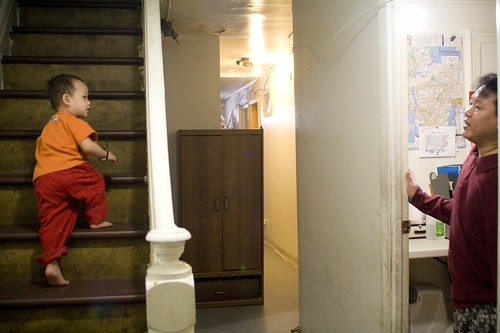 After about 6 months of reporting and an additional month of production, we have finally published our Master's project on Burmese refugees in the greater New York area,From Burma To New York.
After about 6 months of reporting and an additional month of production, we have finally published our Master's project on Burmese refugees in the greater New York area,From Burma To New York.Packaging for multimedia
How do you tackle a project like this which is both politically sensitive and multi-layered. How do you convey the complexity of the resettlement process without boring people? How do you elevate the individual's story from a sea numbers? And how do you construct a project that will encapsulate all dimensions of the resettlement process?
Our answers to these issues consisted of three main mini-documentaries about three individuals, each at a different stage of their resettlement; four interactive features that visualize the larger context; and complementary elements, such as slideshows or short video clips.
Each element was assigned a job: the mini-docs were supposed to bring color into our project. We Se, a newly arrived refugee who used to be a teacher in the refugee camps along the Thai-Burmese border, finds solace in his belief in God and dreams of becoming a Christian pastor one day. Taw Ko, a one-armed father of four, lives in an all-Burmese building where his neighbors and fellow landsmen translate letters for him. Myra Dahgaypaw is doing a Bachelor's degree and is working for the Burmese government in exile several years after her arrival in the U.S.

Taw Ko and his son Lulu in their house in Brooklyn.
A graphic illustrated how many people had fled Burma and were now living in refugee camps along the Thai-Burmese border (151,894 according to the Thailand Burma Border Consortium) and how atrocious the situation was there, which eventually led to what we illustrated in another graphic, namely the sudden admission of about 14,000 Burmese refugees to the United States in the fiscal year of 2007 (an eightfold increase from the year before when only about 1600 were admitted).

Graphic of Thai-Burma Border and the concentration of refugee populations inthe refugee camps there
Moral decisions in reporting on refugees
But all this tech and editorial training was nothing in comparison to the reporting lessons we took home. Not only were we speaking to and taking the time of people who have have lived through gone through some pretty atrocious situations. On top of that, a large number of them have lived in refugee camps for more than 20 years and, before coming here, had no concept of what a key was or how to use Western toilets (the International Organization of Migration actually teaches some of them how to use toilets, among many other skills that are essential for living in the U.S.) and that means that many of these refugees might not have a clear understanding of what it's like to have your face plastered on the global platform that is the internet.
Now, many of these refugees have been ethnically persecuted for being Karen, an ethnic minority in Burma that has been fighting for independence since Burma's independence from British colonial rule. Many Karen Buremse refugees are still facing the same situation. We have encountered many refugees from Burma who have had worries about getting their relatives in Burma into trouble by participating in our project. And in some ways, someone who is struggling with using a microwave might not fully comprehend what it means to partake in a project that will be posted on the internet.
Nicholas Kristof wrote a very interesting column about this issue:
As a reporter, I always feel a tension between the interests of the broader community of refugees — for the most compelling individual stories possible, so the world will pay attention — versus the interest of the individual victim, who often wants privacy and doesn’t want to risk getting in trouble by telling her story.
[...]
And the refugees have no concept of what it means to be in a major newspaper or network broadcast, so you can’t just let them weigh and accept the risks themselves.
That is not to say that we should take away people's agency and presume that refugees aren't at all media savvy. Yet, we had to carefully assess each time whether the people we interviewed really understood what we were doing. We also had to deal with communication problems which made it even more difficult to clarify to our interviewees what were doing.
I guess I'll see what they think when I visit the Ko's on Sunday. Linday Ko, Taw Ko's wife, gave birth to their son Aung He in February. I haven't seen the little boy yet and am mighty exited. I'll have my camera with me. Finally for recreational purposes.


No comments:
Post a Comment